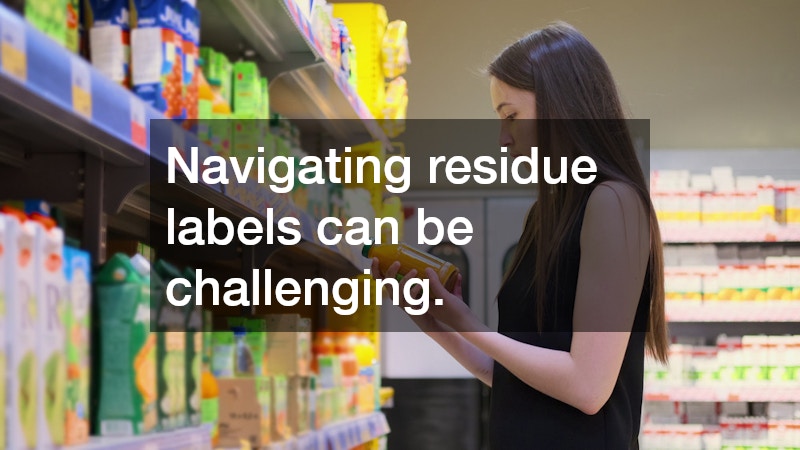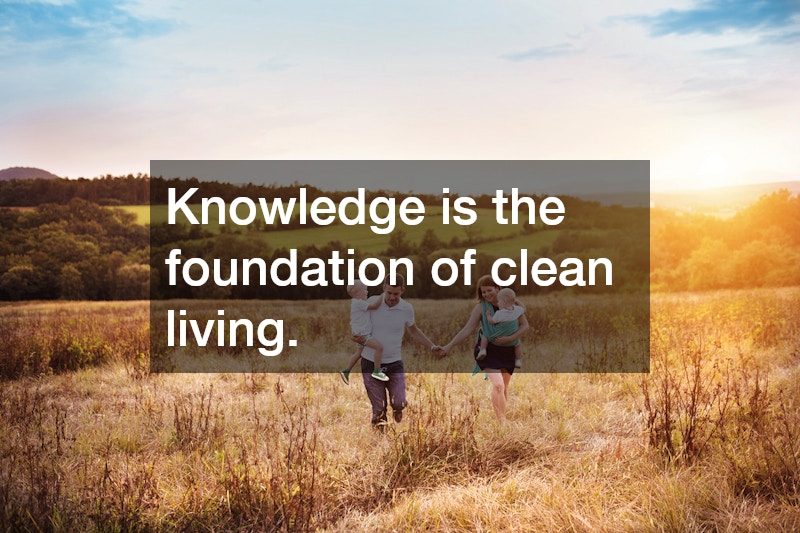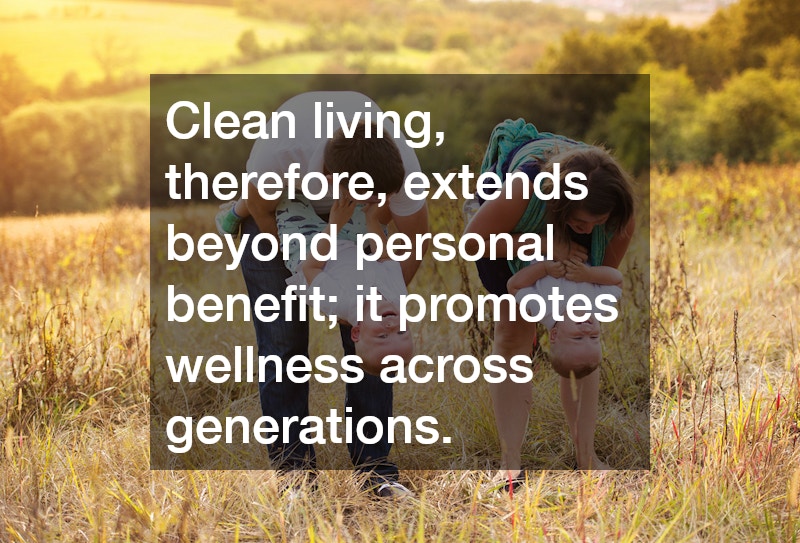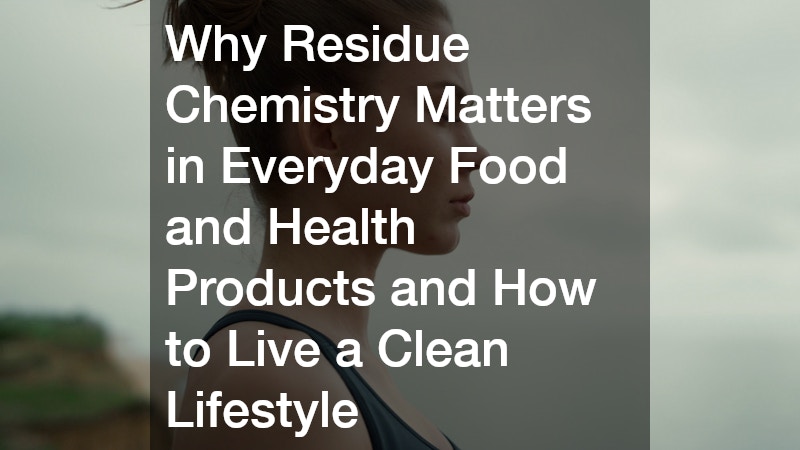Every day, people encounter chemical residues in food, skincare, cleaning products, and even the air they breathe. Understanding residue chemistry is essential for making informed choices that protect your well-being and the environment. From the food we consume to the health products we trust, chemical residues can have long-term effects on health and sustainability. Learning how to live a clean lifestyle involves more than choosing organic—it’s about awareness, prevention, and mindfulness in every purchase and daily habit.
In modern life, where convenience often overshadows caution, residue chemistry plays a silent but significant role. It determines the purity of our food supply, the safety of our personal care products, and the cleanliness of our environment. Whether through volunteering in sustainability projects, consulting alternative medicine practitioners, or making educated consumer choices, adopting a cleaner lifestyle ensures both personal and planetary wellness.
As people explore how to live a clean lifestyle, understanding how residue chemistry influences what enters their bodies becomes crucial. Even simple items like diabetic strips, nutritional supplements, or packaged meals can carry trace contaminants that impact long-term health. Fortunately, growing awareness and technological advancements are helping industries and consumers alike make safer, more transparent decisions. By supporting eco-conscious brands, proper waste disposal, and ethical sourcing, individuals play an active role in reducing harmful residues.
A holistic approach to child development, personal well-being, and environmental stewardship starts with these small, mindful actions. Whether you’re pursuing an online nursing program focused on health education, managing a health club, or simply making better food choices at home, every effort toward understanding residue chemistry supports cleaner living. The journey toward a toxin-free lifestyle begins with knowledge, collaboration, and intentional daily practices that build a healthier future for all.

What Is Residue Chemistry and Why Does It Matter?
The Basics of Residue Chemistry
Residue chemistry refers to the study of chemical remnants that remain in food, personal care products, and the environment after production, processing, or usage. These residues may include pesticides, heavy metals, or artificial additives. Traces of these chemicals persist in our ecosystem, accumulating in soil, water, and living organisms.
Understanding residue chemistry helps consumers make conscious decisions when selecting household and health-related products. For example, people managing chronic conditions—like those monitoring glucose levels with diabetic strips—should be cautious about products that could interfere with their medical devices or medications. Similarly, awareness of residue buildup in skincare or supplements can help prevent allergic reactions or toxicity over time.
The Impact on Health and Environment
Residue chemistry affects human health in subtle yet profound ways. Prolonged exposure to chemical residues may disrupt endocrine functions, affect fertility, or increase the risk of chronic diseases. On an environmental level, residue pollutants can contaminate soil and water, disrupting ecosystems and food chains.
Chiropractors and holistic health professionals often emphasize detoxification and natural treatments to counteract these effects. By adopting practices grounded in clean living, individuals can mitigate their exposure to harmful substances. Understanding how to live a clean lifestyle means identifying these risks early and adopting safer alternatives for your household and diet.
Additionally, an alternative medicine practitioner and a health club management expert advocates for balanced nutrition, stress reduction, and mindful product use to support detoxification. Even small steps, such as choosing organic produce, using eco-friendly cleaning supplies, or properly handling waste disposal, can significantly reduce the accumulation of toxic residues. Embracing these mindful habits not only promotes physical health but also contributes to the sustainability of the planet—making clean living a powerful act of personal and environmental responsibility.
Recognizing Residue Labels and Certifications
Navigating residue labels can be challenging. However, certifications like USDA Organic, Non-GMO Project Verified, and Fair Trade are reliable indicators of cleaner, more ethical production practices. These certifications ensure reduced chemical usage in farming and product manufacturing. In the same way, responsible waste disposal processes at the industry level prevent harmful residues from entering our water systems.
Consumers who seek out certified products demonstrate a commitment to their health and the planet. Whether through researching product labels or engaging in volunteer services that promote sustainability education, every effort contributes to broader community awareness. Taking the time to verify these certifications not only supports trustworthy brands but also empowers individuals to make meaningful choices. As more people learn how to live a clean lifestyle, demand for transparency and accountability in production grows—paving the way for healthier markets, cleaner ecosystems, and a more informed consumer base dedicated to long-term well-being.
How Do Residue Chemicals Affect Our Food Supply?
Pesticides and Fertilizers in Agriculture
Chemical pesticides and fertilizers, though effective in improving crop yields, often leave behind residues that make their way into fruits, vegetables, and grains. Residue chemistry in agriculture is a global concern, as these substances can remain in soil for years. Long-term exposure may lead to digestive issues, hormone imbalance, and even neurological problems.
To counter these effects, many farmers are turning to organic methods and eco-friendly waste disposal systems. These practices reduce contamination, ensuring safer and healthier produce. Consumers can further protect themselves by washing produce thoroughly and choosing locally grown or certified organic food whenever possible.
Processing and Packaging Contaminants
Residues are not limited to agricultural chemicals—they also emerge during food processing and packaging. Substances like BPA, preservatives, and artificial dyes may leach into foods, affecting both flavor and safety. Residue chemistry helps scientists identify these contaminants and develop safer packaging alternatives.
Additionally, professionals in health club management are recognizing the importance of residue-free nutrition, especially for athletes who depend on pure, nutrient-rich diets. Incorporating clean eating habits into your daily routine aligns with the principles of how to live a clean lifestyle—reducing unnecessary chemical exposure while promoting better energy and performance.
Regulations and Safety Standards
Governments and regulatory agencies such as the FDA and EPA play crucial roles in setting residue limits and monitoring compliance. These regulations ensure that chemicals used in farming and manufacturing remain within safe thresholds. However, enforcement varies globally, making it vital for consumers to stay informed.
Supporting local initiatives and volunteer services that advocate for stricter safety standards helps maintain accountability within industries. Active participation in community sustainability programs can also drive change from the ground up, ensuring that future generations inherit a cleaner, safer food system.

How Can We Minimize Exposure to Residues in Health Products?
Choosing Organic and Natural Options
Selecting organic or natural health products is a simple yet effective way to reduce exposure to harmful residues. These items are produced without synthetic chemicals or artificial additives. For example, alternative medicine practitioners often recommend herbal remedies and natural oils that avoid synthetic preservatives found in conventional products.
Even those enrolled in an online nursing program can benefit from understanding these concepts, as patient education increasingly includes discussions about environmental health and clean living. Making conscious choices about body lotions, supplements, and hygiene products significantly lowers daily chemical intake.
Understanding Ingredient Labels
Reading and interpreting ingredient labels is vital for identifying potential hazards. Avoiding ingredients such as parabens, sulfates, and phthalates reduces chemical exposure. Products labeled “residue-free” or “organic-certified” offer an added layer of safety assurance.
This level of awareness also extends to food packaging and household cleaners. Knowing how to identify safe alternatives is an important part of how to live a clean lifestyle, ensuring you and your family are not unintentionally exposed to harmful chemicals.
DIY Health Product Alternatives
Homemade alternatives—like natural deodorants, face masks, or cleaning sprays—can effectively replace many commercial products laden with residues. Making your own items using ingredients such as vinegar, baking soda, or essential oils ensures control over what you apply to your body and surfaces.
Collaborating with professionals like chiropractors or holistic wellness coaches can also provide insights into natural detoxification and self-care practices. These experts often integrate nutritional advice, natural therapies, and movement into a comprehensive clean-living approach.
What Role Do Government and Industry Play in Ensuring Safety?
Regulatory Bodies and Their Responsibilities
Government agencies such as the EPA, FDA, and USDA monitor and regulate the presence of chemical residues in food and consumer goods. They set maximum residue limits (MRLs) and oversee testing procedures to ensure compliance.
However, regulatory gaps still exist. Ongoing research in residue chemistry continues to identify new contaminants, pushing for tighter regulations and improved transparency. Advocacy from educational institutions, including those offering online nursing programs, helps bridge these gaps by spreading awareness and encouraging policy reform.

Industry Best Practices and Innovations
Leading industries are adopting cleaner production practices. From eco-friendly packaging to sustainable waste disposal systems, innovation is driving a shift toward cleaner operations. Some companies now invest in renewable energy and non-toxic materials to reduce their chemical footprint.
Even sectors like health club management are embracing residue-free products in their facilities, ensuring cleaner air, equipment, and nutrition for members. These innovations reflect a growing recognition of how to live a clean lifestyle as both a personal and corporate responsibility.
Consumer Advocacy and Influence
Consumers wield immense influence. By supporting ethical brands and demanding transparency, they can accelerate industry-wide change. Writing reviews, participating in local sustainability programs, or volunteering with environmental organizations all contribute to positive reform.
Collective action often inspires new legislation, increased accountability, and higher safety standards. The integration of community-driven initiatives and informed consumer choices creates a cycle of awareness that fosters cleaner, safer living environments.
How to Live a Clean Lifestyle: Practical Steps and Strategies
Building Awareness and Education
Knowledge is the foundation of clean living. Educating yourself about residue sources and their health impacts enables better decision-making. Reading scientific studies, attending community workshops, or consulting professionals in alternative medicine and nutrition can help refine your lifestyle habits.
Some individuals even dedicate time to volunteer services focused on environmental restoration or public health education. By participating in community projects, you not only strengthen your understanding of sustainability but also help others learn how to live a clean lifestyle.
Incorporating Clean Lifestyle Habits
Living a clean lifestyle involves more than just buying organic produce—it’s about consistency and mindfulness. Begin by reducing single-use plastics, improving indoor air quality, and selecting natural cleaning agents. Regular exercise and balanced nutrition, guided by experts in health club management or holistic care, further enhance physical and mental well-being.
Additionally, supporting sustainable farming, responsible tree removal, and safe waste disposal practices helps reduce your overall ecological footprint. Integrating eco-conscious decisions into your everyday routine leads to a cleaner, healthier world.
Community and Support Networks
Clean living is easier when shared. Joining groups focused on environmental health, such as local co-ops or community gardens, provides valuable support. Many people, including students studying in an online nursing program, find motivation and accountability in these collective efforts.
For families, incorporating a holistic approach to child development that emphasizes nutrition, nature, and mindfulness fosters long-term wellness. Parents can teach children about sustainability and the importance of avoiding harmful residues, setting the stage for a lifetime of clean living.
Even those who act as an egg donor can benefit from maintaining a clean lifestyle—detoxifying the body through nutrition and natural products enhances health for both donors and recipients. Clean living, therefore, extends beyond personal benefit; it promotes wellness across generations.
Residue chemistry touches every aspect of modern life, from what we eat to the products we trust for health and wellness. Understanding its effects empowers individuals to make smarter, safer choices. Reducing exposure through organic options, sustainable waste management, and mindful purchasing directly contributes to better health outcomes and environmental preservation.
As society becomes more aware of these issues, individuals—from chiropractors to alternative medicine practitioners, from environmental volunteers to healthcare students—are leading the shift toward a cleaner, more conscious way of living.
Knowing how to live a clean lifestyle means taking small, intentional steps: reading labels, supporting eco-friendly industries, and educating others. Whether through volunteer services, sustainable agriculture, or responsible consumption, every action matters.
Ultimately, embracing cleaner living isn’t just a trend—it’s a necessity for long-term wellness. With knowledge, commitment, and community support, anyone can minimize exposure to harmful residues and cultivate a lifestyle that prioritizes health, balance, and environmental harmony.

